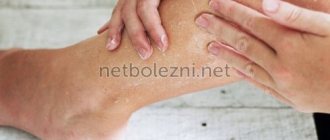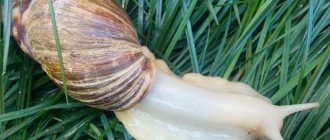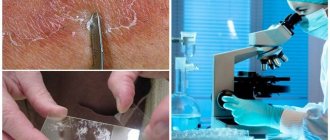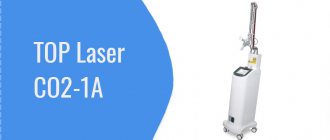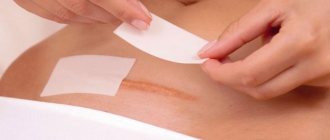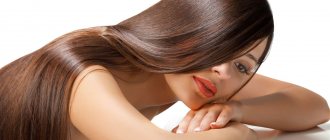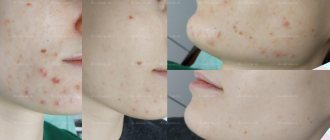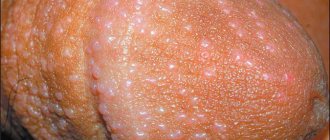Published in the journal: “EFFECTIVE PHARMACOTHERAPY”; No. 45; 2015; pp. 14-18.
THEM. Korsunskaya1, E.V. Dvoryankova1, K.T. Plieva1, O.O. Melnichenko1, 2, S.V. Panyukova1, 2
1 Center for Theoretical Problems of Physicochemical Pharmacology
2 Moscow Scientific and Practical Center of Dermatovenereology and Cosmetology
The article discusses the pathogenesis of skin itching, possible psycho-emotional problems and somatic triggers of itching. The advantages of second-generation antihistamines, in particular cetirizine, are described: in addition to blocking H1-histamine receptors, the drug inhibits the migration of eosinophils in the area of inflammation and suppresses the skin response to platelet-activating factor. The results of our own studies showing the effectiveness of cetirizine in dermatological diseases are presented. Namely: maximum reduction in itching intensity within 3 hours after use during the first five days of therapy.
The skin makes up about 15% of the total human body weight and is the largest organ. Its most important function is protective.
The condition of the skin has a significant impact on a person’s self-esteem and the formation of interpersonal relationships. Itching is an unpleasant subjective sensation that causes the desire to scratch. This symptom in the vast majority of cases causes discomfort, psycho-emotional stress and exhaustion. In addition, scratching damages the integrity of the skin. It should be noted that, despite the high prevalence of the symptom, it has not been sufficiently studied due to the difficulties of its adequate assessment and the lack of models for research.
Pathophysiology
Signals for pain and itching caused by skin causes are transmitted along the same pathways, but the afferent C-fibers differ functionally: one part of the nerve fibers is stimulated by histamine, the other by other substances that cause itching (for example, serotonin). There is evidence of similarities between neuropathic pain, itch and cough. Their common property is peripheral and central sensitization of the afferent nervous system. This explains the effectiveness of antiepileptic drugs and antidepressants for such a variety of conditions, as well as the ineffectiveness or low effectiveness of H1 blockers for some types of itch.
Mechanisms and mediators involved in the formation of the sensation of itching:
- amines (histamine, serotonin, acetylcholine);
- proteases and kinins (tryptase, chymase, kallikrein, bradykini, etc.);
- neuropeptides (substance P, neurotensin, etc.);
- cytokines (prostaglandin E reduces the threshold for susceptibility to itching);
- opioid receptors (metenkephalin, leuenkephalin, β-endorphin), naloxone reduces itching, opiates relieve pain but increase itching.
Mechanisms of development and relief of itching
Hypotheses about the mechanisms of development of itching have been formulated based on studies of the pathophysiology of pain, since pain and itching share common molecular and neurophysiological mechanisms.
The sensation of both itching and pain results from the activation of a network of free nerve endings in the dermal-epidermal zone. The triggering mechanism is the influence of internal or external thermal, mechanical, chemical stimuli or electrical stimulation. Cutaneous nerve irritation can be mediated by several biological agents, including histamine, vasoactive peptides, enkephalins, substance P, and prostaglandins.
It is believed that other, non-anatomical factors, such as psycho-emotional stress, individual subjective perception, the presence and intensity of other sensations and/or distractions, have a significant impact on the degree of sensitivity of itching in different areas of the skin.
The nerve impulse that causes the sensation of itching, which arose under the influence of any of the listed factors, is transmitted through the same neural connection as pain impulses: from peripheral nerve endings to the dorsal horns of the spinal cord, through the anterior commissure, along the spinothalamic tract to the contralateral laminar nucleus of the thalamus. It is hypothesized that the thalamocortical tertiary neuron tract acts as a “relay” for impulse transmission through the integration of the thalamic reticular activating system in several brain regions. In response, there is a desire to scratch the skin, which is formed in the corticothalamic center and is realized in the form of a spinal reflex. After scratching, skin itching occurs again after 15-25 minutes. However, in some cases, especially in patients with chronic dermatoses, the itching sensation after scratching does not stop, which leads to excoriation.
Despite the fact that many etiological and pathogenetic factors contributing to the occurrence of itching are currently known, their study continues and new mechanisms of its development are being discovered.
The mechanism by which itching is relieved by scratching has not been reliably established. It is possible that during scratching, sensory impulses are generated that interrupt the neural arc responsible for the occurrence of sensation.
In addition to scratching, vibration, injections into the itchy area, exposure to heat, cold, and ultraviolet radiation help reduce itching [3].
Pharmacotherapy of hay fever consists of the use of pharmacological agents aimed at eliminating the main symptoms of rhinitis, conjunctivitis, and bronchial asthma. In pharmacotherapy of AR, in turn, the following groups of drugs are used: antihistamines (inverse agonists of H1 receptors), glucocorticosteroids, mast cell membrane stabilizers (cromones), vasoconstrictors (decongestants), less often - anticholinergics, antileukotriene drugs, monoclonal anti-IgE antibodies (Table 2).
Classification
By prevalence
Localized:
- non-specific:
dry skin, parasitic diseases, skin diseases (eczema, bullous pemphigoid, etc.), fungal skin lesions, allergic skin manifestations, insect bites, contact dermatitis;
- specific for oncological diseases:
melanomatosis (for cancer of the anus and vulva), glioblastoma, metastatic skin lesions, paraneoplastic syndrome.
Generalized:
- non-specific:
primary skin diseases, endocrine diseases (hypothyroidism, thyrotoxicosis, diabetes mellitus), carcinoid syndrome, diseases accompanied by cholestasis, blood diseases (for example, Vaquez disease), neurological diseases, senile pruritus, psychogenic pruritus, pruritus caused by infectious diseases, iatrogenic pruritus ( side effects of drugs);
- specific for oncological diseases:
chronic lymphocytic leukemia, Hodgkin's disease, lymphomas, mycosis fungoides (a type of T-cell lymphoma), multiple myeloma, paraneoplastic syndrome.
By genesis
Central:
• neuropathic: brain abscess, brain injury, brain tumor, multiple sclerosis;
• neurogenic: cholestasis, opioids, paraneoplastic process;
• psychogenic: psychosomatic disorder manifested by itching.
Peripheral:
• cutaneous, “pruritoceptive”: cutaneous mastocytosis, medications (± rash), infestations (scabies, lice, fleas, mites), primary skin diseases, plant burns, urticaria;
• neuropathic: postherpetic neuralgia.
Mixed: central and peripheral – uremia.
Diagnostics
Anamnesis
- Localization : focal or generalized.
- Onset : acute onset is the least characteristic of systemic diseases.
- Duration.
- Nature/character : severe, constant itching, worsening in the evening - scabies;
- “burning” itching – perpetiform dermatitis;
- “tingling” – polycythemia.
Physical examination
- Careful examination of the skin: primary lesions;
- excoriation of the skin in various areas (pediculosis, scabies);
- inflammatory papules on the legs with a small vesicle in the center (flea bites);
- “butterfly” sign in the upper central part of the back (hepatobiliary pathology);
- uremic chills.
Laboratory research
Complete blood count with leukoformula, urea, creatinine, liver tests (markers of cholestasis - alkaline phosphatase, gamma-glutamyl transpeptidase (GGT), determination of bilirubin), thyroxine (T-4) and thyroid-stimulating hormone (TSH), blood glucose.
Patient management
General events
- If your skin is dry, use soap substitutes with a moisturizing effect instead of soap, and apply moisturizing cream to your skin 2-3 times a day.
- Review the list of medications you are taking: if a possible cause of itching is a medication, it needs to be changed.
- For atopic/contact dermatitis: topical corticosteroids once a day for 2-3 days if there is inflammation but no infection.
- For scabies: topical permethrin or malathion.
- For cholestatic itching due to obstruction of the common bile duct: duct stenting – if possible.
Nonspecific treatment
It is carried out taking into account the condition of the skin - different approaches to local treatment on intact and macerated skin.
Antipruritic agents for topical use : 0.5−2% cream with levomenthol (menthol) is effective on intact skin if the itching is localized or more intense in a certain area.
Sedating antihistamines can be prescribed 1 hour before bedtime; if the effect does not persist for a day, two-time use is possible:
- Hydroxyzine/Atarax, Vistaril 25 mg orally at night;
- promethazine/Pipolfen 25 mg orally at night;
- diphenhydramine/Diphenhydramine 50 mg orally 1–2 times a day;
- Dimetindene/Fenistil 1 mg orally daily plus Fenistil gel (0.1% dimethindene) topically 3 times a day will help in most difficult cases.
Some non-sedating antihistamines may have an antipruritic effect (eg, loratadine/Claritin, cetirizine/Zodac, Zyrtec).
Antihistamines for external use (for example, Fenistil cream) on intact skin are used for no longer than a few days in cases where itching is caused by the release of histamine (for example, acute drug rash).
TCAs with antihistamine properties : doxepin/Doxepin in a dose of 10-75 mg orally at night. Antidepressants will help in cases where anxiety or depression occurs.
Specific treatment
Table 1 and Appendix 1 present the principles and regimens of drug therapy for itching of various etiologies.
Cetirizine
Cetirizine inhibits the histamine-mediated early phase of the allergic reaction, prevents various physiological and pathophysiological effects of histamine, such as dilation and increased capillary permeability (development of edema, urticaria, redness), stimulation of sensory nerve endings (itching, pain) and contraction of smooth muscles of the respiratory and gastrointestinal tract. intestinal tract.
In the late stage of an allergic reaction, cetirizine not only inhibits the release of histamine, but also the migration of eosinophils and other cells, thereby attenuating the late allergic reaction. Reduces the expression of adhesion molecules, such as intercellular adhesion molecule-1 (ICAM-1) and vascular cellular adhesion molecule-1 (VCAM-1), which are markers allergic inflammation.
In addition, unlike other drugs used for skin manifestations of allergies, cetirizine not only blocks H1-histamine receptors, but also suppresses the skin response to platelet-activating factor [6, 7]. This is confirmed by the results of numerous clinical comparative studies: the ability to accumulate in the skin allows the drug to relieve itching and hyperemia more effectively than drugs such as ebastine, epinastine, terfenadine, fexofenadine and loratadine [8-10].
Cetirizine has a low volume of distribution compared to other antihistamines - 0.5 l/kg. This provides higher concentrations of the substance in the extracellular space, where H1-histamine receptors are located. This ensures their full employment and the highest antihistamine effect [11]. Another feature of the drug is its high ability to penetrate the skin. 24 hours after taking a single dose of cetirizine, the concentration in the skin is equal to or even slightly higher than the concentration in the blood. The advantage of cetirizine is its steroid-sparing effect: with the simultaneous administration of cetirizine and inhaled glucocorticosteroids in patients with bronchial asthma, the dose of the latter can be reduced or not increased, despite contact with the allergen.
Among cetirizines, Cetrin occupies a special place. In the study by E.E. Nekrasova et al. in patients with chronic urticaria, Cetrin showed the highest effectiveness among other generic cetirizine and the best results in terms of pharmacoeconomics [12].
Useful tips
Systemic treatment is often not necessary if the skin condition improves.
If your skin becomes dry, stop using soap; bathing in warm rather than hot water, lubricating the skin after bathing and at night, applying a damp cloth for 15–20 minutes, then applying cream or ointment.
For damp skin - protective cream (zinc paste), drying dressings with Burov's liquid (aluminum acetate 8%, diluted 1:10–1:20).
Local anti-itch remedies
Zinc oxide has anti-inflammatory, antiseptic and antipruritic effects, and is used in concentrations of 10–50% in creams, liniments, lotions, ointments and pastes that are effective in the treatment of localized forms of itching.
Menthol, when applied to the skin and mucous membranes, dilates blood vessels, causing a feeling of coldness and then numbness, significantly reducing itching. It is used in powders, ointments, and lotions in concentrations of 1–10%.
Camphor , when applied to the skin, produces a warm sensation followed by mild anesthesia, which reduces itching. It is used in the form of liniments, lotions and ointments in concentrations of 2–20%.
Important
It should be remembered that products with menthol and camphor cannot be used simultaneously on one area of the skin.
Calamine , a lotion containing zinc carbonate (calamine), zinc oxide and a small amount of phenol, is widely used in the treatment of itching and atopic dermatitis.
Popular questions
I am concerned about itching and unpleasant smell.
Hello! The appearance of odor and itching in the genital tract may indicate an inflammatory process, dysbacteriosis, or a more serious disease. Therefore, you need to see a specialist and undergo an examination: a smear for flora, examinations to identify specific and nonspecific microflora (for example, vaginal culture or femoflora analysis). This will allow you to prescribe etiotropic therapy. At this stage, before receiving the results of the examinations, you can use Gynocomfort gel with tea tree oil to prevent the spread of inflammation. The composition will help eliminate itching and odor, relieve swelling and restore the condition of the mucous membranes. The gel is used in 1 dose 1 time per day for 7-10 days. It is introduced into the genital tract using an applicator.
Both my partner and I began to itch. Before this we took antibiotics. Will Gynocomfort gel help?
Hello! Most often, after taking antibiotics, dysbiosis develops associated with a yeast fungus of the genus Candida. To clarify the nature of the itching, you still need to contact an obstetrician-gynecologist and urologist, respectively, and conduct an examination - a smear on the flora. Until you get the result, you can use Gynocomfort gel with tea tree oil. This will relieve itching and accelerate the anti-inflammatory effect. The gel is administered 1 dose 1 time per day for 10 days using an applicator.
Hello, I have a burning and itching of the genitals, please tell me what can be done?
Hello! At this stage, you can use Gynocomfort gel with tea tree oil, which will have an anti-inflammatory effect and eliminate swelling and burning. And then you need to contact an obstetrician-gynecologist for an examination to identify the cause of the disease.
After sexual intercourse, itching and burning began and it is very itchy, sometimes there is pain, it hurts to walk small to the toilet, sometimes but not often there is a white discharge, and menstruation should begin soon. I apply clotrimazole 2 times a day, the itching subsides during the day and appears in the morning.
Hello!
Such manifestations indicate an inflammatory process in the genital tract and a possible ascending infection in the urinary system. See a doctor as soon as possible, conduct an examination to identify the inflammatory factor and carry out treatment to the required extent. For an accurate diagnosis, contact a specialist
Care Tips
- Prevention of scratching: short-filed nails, lightly rubbing itchy areas.
- After washing, dry your skin carefully using wet movements, use a soft towel or a hair dryer on a cold setting.
- Avoid long hot baths. Try a bath with sodium bicarbonate (baking soda) or medicated oils.
- Use loose clothing and loose bedding/blankets.
- Avoid overheating and sweating, especially during night sleep.
- Increase the humidity in the bedroom so that your skin loses less moisture.
- Wear cotton gloves at night to prevent scratching.
- Avoid damaging the skin with alcohol-containing rubbing, woolen clothing, and excessive hygiene procedures.
- Cleanse your skin gently using moisturizers.
- Use cooling, soft compresses.
- You can use an anesthetic mixture: aftershave cream with menthol 50 ml, Diphenhydramine 1% 3–5 ml, Lidocaine 2% 1–2 ml, Novocaine 0.5% 5–10 ml. Mix and serve chilled.
- Use relaxation and positive visualization techniques.
Overview of Soothing Natural Remedies
Products that soothe facial skin should be developed based on natural ingredients. The main thing is to approach home care wisely. Don't overdo it and take daily baths or use too many cosmetics. Active substances may begin to “argue,” which will only aggravate the situation and increase irritation. In this case, such a statement as “I’ll put more in, I’ll sit longer” doesn’t work. Everything is good in moderation.
If you don’t know how to soothe your skin from irritation, check out the list of the most effective and safest products:
- Salt scrubs. Suitable for sensitive skin, because abrasive particles dissolve in water, exfoliating gently and without damaging the epidermis. They have a pronounced regenerating and antiseptic effect. The essential oils included in the composition nourish the skin, increasing elasticity and maintaining water balance. They will have an antibacterial effect and soothe the skin. The result is softness and silkiness without inflammation or irritation.
- Tropical Touch Coconut Milk Scrub. A delicate product suitable for dry, thin and sensitive skin. Formulated with Epsom salts, grape seed oil, coconut flakes and coconut milk powder. At the same time, it cleanses and nourishes the skin, improving its structure and increasing its protective properties. Organic ingredients rejuvenate and moisturize the skin, restoring its natural beauty.
- Home SPA. Mixes of sea, Himalayan and Epsom salts, dried chamomile and calendula flowers and bath bombs developed on the basis of baking soda have a complex effect, effectively eliminating the problem of irritated skin.
- White Velvet Blend. Contains three types of natural salt, dry cream, jasmine buds, macadamia and almond oil, white clay and coconut milk. The recipe was developed based on the ancient recipe for Cleopatra's bath. The unique composition provides hydration and nutrition.
- Set of bath salts. Epsom salt eliminates swelling and has a lymphatic drainage effect; pink (Himalayan) – contains 84 minerals, nourishing, moisturizing and increasing skin elasticity; Dead Sea – rejuvenates and increases the protective barrier; Crimean - moisturize and smooth the epidermis.
To ensure complete skin care and prevent irritation, it is recommended to use a dry massage brush. The procedure gently exfoliates dead cells, stimulating blood circulation. Dry rubbing helps restore not only the upper but also the deep layers of the skin. Dried cactus fibers help prevent skin irritation by stimulating the protective properties of the epidermis. As a result, the skin becomes silky and toned.
Cosmetics without fragrances, parabens and preservatives are much safer and more effective than the products that many of us are used to using. You can achieve ideal skin condition with the help of natural oils and salts. Natural products created by nature are effective for the beauty of the face, body and hair, and also help achieve peace of mind.
Natural cosmetics replace salon procedures, solving problems quickly and comprehensively. Natural monocomponent products, with regular use, give visible and lasting results. If there are a lot of substances in cosmetic products, then this only worsens the situation, confusing the skin. Cosmetics should contain only those substances that are really necessary (panthenol, hyaluronic acid, vegetable oils, etc.). This approach allows you to quickly cope with irritation, soothing and restoring the skin.
